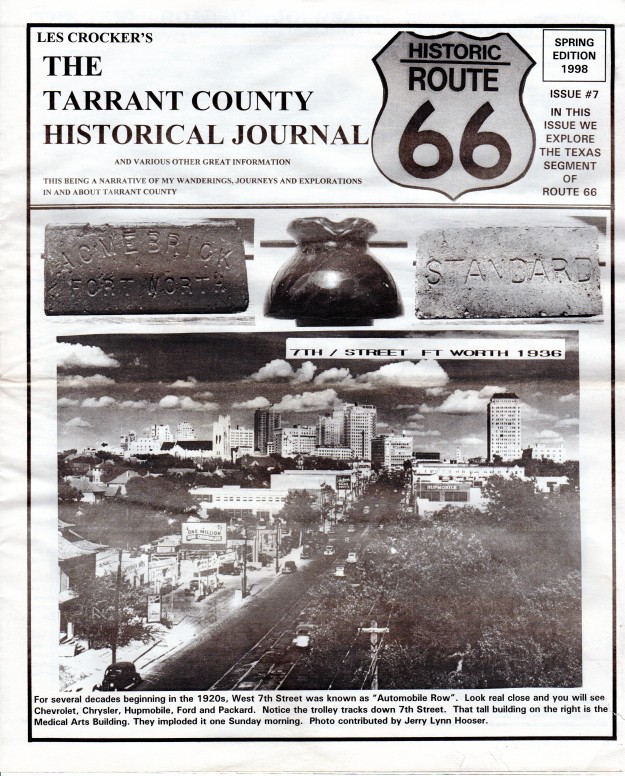The following is just a sample of the pictures and articles in the 20 pages of issue #9.
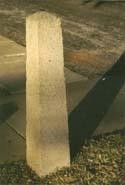 This concrete marker is intended to mark the site of the last indian battle in Tarrant County. It is at 1516 Rio Grande and 1500 Summit.
This concrete marker is intended to mark the site of the last indian battle in Tarrant County. It is at 1516 Rio Grande and 1500 Summit.
The Holiday Inn, Beach at I-30, Ft. Worth
Probably the only hotel in the world with it’s own cemetery on it’s grounds. In 1970 a Mr. John Hickman of Ft. Worth and Judge Robert Hall of Dallas decided to build a hotel on the Sycamore Heights Bluff overlooking the then Fort Worth-Dallas Turnpike, but they had two problems. One, there appeared to be a small private cemetery right where they wanted to build the hotel. The cemetery is the Pioneer Ayres Graveyard. 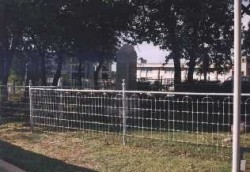 Buried there is Benjamin Ayres and his wife Emily. Four of his six sons are buried here, John, Joe, C.A., and Ben, Jr. Also buried on the hotel grounds are Isabella Sanderson, Ayres daughter and her husband, William Sanderson. Another daughter, Mary Ayres Cushman, (born Dec. 22, 1874, died Aug. 23, 1952) is also interned here. Over the years many others were buried in this two acre plot, some friends and some strangers, many of them children who died while traveling West by wagon.
Buried there is Benjamin Ayres and his wife Emily. Four of his six sons are buried here, John, Joe, C.A., and Ben, Jr. Also buried on the hotel grounds are Isabella Sanderson, Ayres daughter and her husband, William Sanderson. Another daughter, Mary Ayres Cushman, (born Dec. 22, 1874, died Aug. 23, 1952) is also interned here. Over the years many others were buried in this two acre plot, some friends and some strangers, many of them children who died while traveling West by wagon.
Mr. Hickman decided to leave the cemetery and build the hotel around it. It has become quite a tourist attraction over the years. Mr. Hickman promised to give the cemetery perpetual care.
Now to the other problem. It was a stinky one. A pig farm located just to the west of the proposed hotel and south of the Turnpike. What to do? The Ft. Worth City Council tried to discourage it by declaring the pig business a nuisance and a zoning violation. But, the pig farmers stayed.
(Editor’s note: I remember just after the Turnpike was built and in the
days before most cars had air conditioners whenever we would pass the pig
farm we would roll up our windows to keep out the smell. It didn’t work.
P-U-EE!)
Finally, the owners of the pig farm, worn out by the constant hassle, sold out. A Federal Agricultural Building was built soon after on the site and the hotel soon after that. After Fort Worth was abandoned by the Army in 1853, merchants and traders took over the empty buildings. They called the new town “Fort Town “. By 1856 Fort Town was again being known as “Fort Worth”. Aren’t you glad? “Yes, I am from Fort Town” doesn’t sound as cool as “Yep, I’m from “Foat Wuth”.
(Editor’s note: I seem to recall that when the Turnpike was built it split the pig farmer’s land into with no access to the north side of the Turnpike. I had heard that a tunnel was built under the Turnpike to allow access to the other side. I may check this out someday.)
Benjamin Ayres came to Tarrant County in 1848 from Tennessee. He was probably pretty wealthy as he had sold his plantation to come here. Mr. Ayres claimed his land on Sycamore Creek. He owned 320 acres in what is now Meadowbrook. He was active in local politics and helped organize the First Christian Church in Fort Worth in 1851. The Christian Church he helped organize still stands today at 6th and Throckmorton St.
Ben Ayres served as Tarrant County’s second County Clerk from 1852 to 1856. He died in 1862. Ayres Street is named for him.
(Editor’s note: Okay, I checked out the tunnel story. There is not one as such. Mr. Miller (pig farm owner) had his 100 pig farm right on Sycamore Creek. When they built the Turnpike over Sycamore Creek, they left enough room on both sides of the creek under the bridge to drive over to the north side of the Turnpike.)

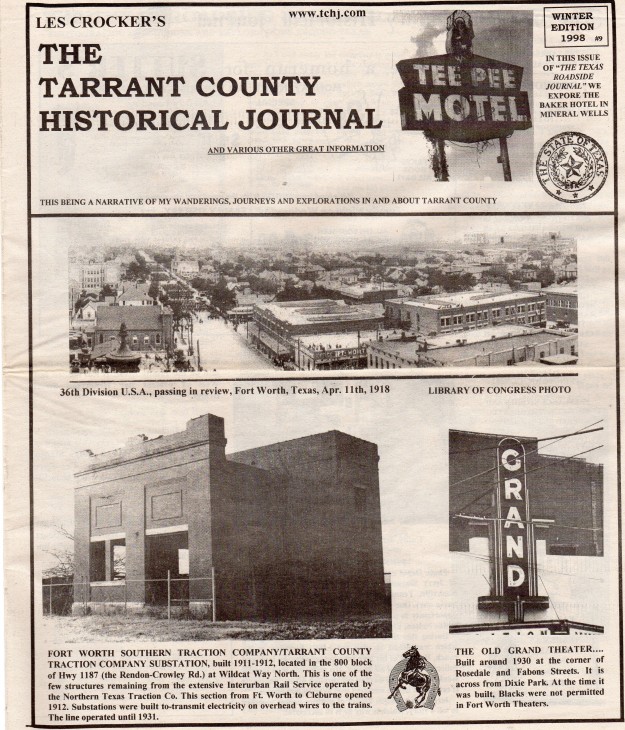
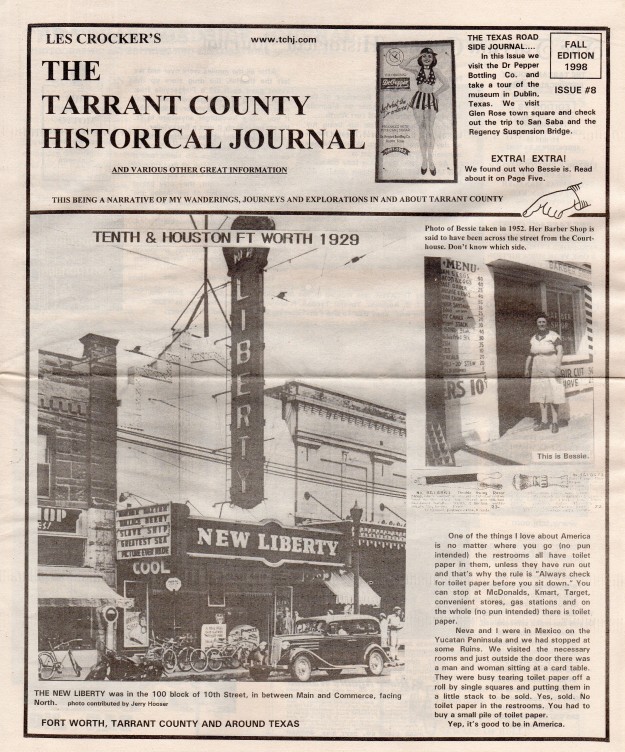
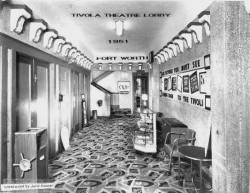
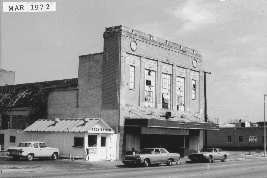
 Pioneers Rest Cemetery This burial ground was started in the summer of 1850 upon the deaths of Sophie and Willis Arnold, children Major Ripley A. Arnold, Commander of the Troops at Fort Worth. Many early Fort Worth settlers, including 75 Civil War Veterans are buried here.
Pioneers Rest Cemetery This burial ground was started in the summer of 1850 upon the deaths of Sophie and Willis Arnold, children Major Ripley A. Arnold, Commander of the Troops at Fort Worth. Many early Fort Worth settlers, including 75 Civil War Veterans are buried here. 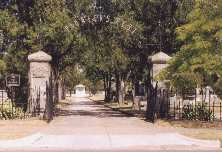 Buried here also are Major Arnold and General Edward H. Tarrant for whom Tarrant County was named. General Edward H. Tarrant arrived in Texas in November 1835 settling in Red River County. He served in the Republic of Texas Congress and became a Brigadier General in the Texas Militia in 1839. He commanded the Texas Rangers at the Battle of Village Creek in present Tarrant County in 1841. With George W. Terrell, negotiated treaties with many of the Texas Indian tribes at Bird’s Fort in 1843. He died in Parker County in 1858 and was buried there. In 1928 his body was reentered here by the Daughters of the Republic of Texas. Tarrant County was named in his honor.
Buried here also are Major Arnold and General Edward H. Tarrant for whom Tarrant County was named. General Edward H. Tarrant arrived in Texas in November 1835 settling in Red River County. He served in the Republic of Texas Congress and became a Brigadier General in the Texas Militia in 1839. He commanded the Texas Rangers at the Battle of Village Creek in present Tarrant County in 1841. With George W. Terrell, negotiated treaties with many of the Texas Indian tribes at Bird’s Fort in 1843. He died in Parker County in 1858 and was buried there. In 1928 his body was reentered here by the Daughters of the Republic of Texas. Tarrant County was named in his honor. 